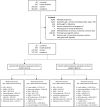Pregnancy outcomes of women with previous caesarean sections: Secondary analysis of World Health Organization Multicountry Survey on Maternal and Newborn Health
- PMID: 31278298
- PMCID: PMC6611838
- DOI: 10.1038/s41598-019-46153-4
Pregnancy outcomes of women with previous caesarean sections: Secondary analysis of World Health Organization Multicountry Survey on Maternal and Newborn Health
Abstract
Secondary analysis of World Health Organization Multicountry Survey on Maternal and Newborn Health (WHOMCS) was undertaken among 173,124 multiparous women to assess the association between previous caesarean sections (CS) and pregnancy outcomes. Maternal outcomes included maternal near miss (MNM), maternal death (MD), severe maternal outcomes (SMO), abnormal placentation, and uterine rupture. Neonatal outcomes were stillbirth, early neonatal death, perinatal death, neonatal near miss (NNM), neonatal intensive care unit (NICU) admission, and preterm birth. Previous CS was associated with increased risks of uterine rupture (adjusted Odds Ratio (aOR); 7.74; 95% confidence interval (CI) 5.48, 10.92); morbidly adherent placenta (aOR 2.60; 95% CI 1.98, 3.40), MNM (aOR 1.91; 95% CI 1.59, 2.28), SMO (aOR 1.80; 95% CI 1.52, 2.13), placenta previa (aOR 1.76; 95% CI 1.49, 2.07). For neonatal outcomes, previous CS was associated with increased risks of NICU admission (aOR 1.31; 95% CI 1.23, 1.39), neonatal near miss (aOR 1.19; 95% CI 1.12, 1.26), preterm birth (aOR 1.07; 95% CI 1.01, 1.14), and decreased risk of macerated stillbirth (aOR 0.80; 95% CI 0.67, 0.95). Previous CS was associated with serious morbidity in future pregnancies. However, these findings should be cautiously interpreted due to lacking data on indications of previous CS.
Conflict of interest statement
The authors declare no competing interests.
Figures
References
Publication types
MeSH terms
Grants and funding
LinkOut - more resources
Full Text Sources
Medical
Miscellaneous


